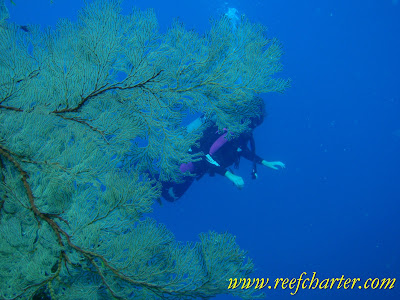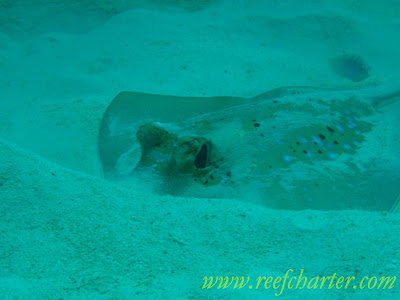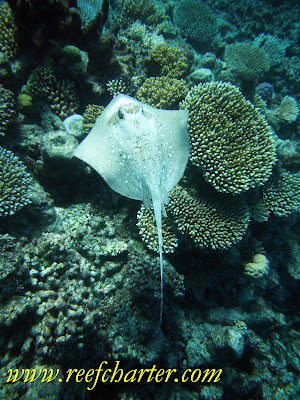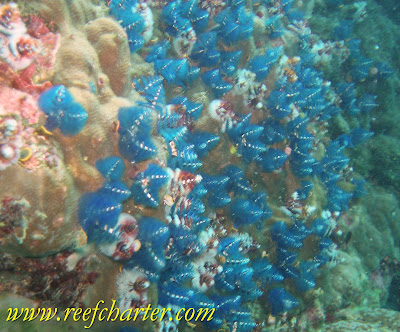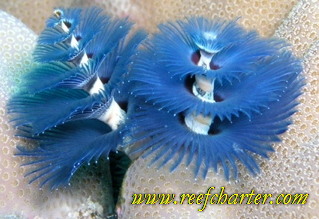The Gorgonian or Fan Coral as it is commonly refered to is one of the favourites of the scuba divers on our Great Barrier Reef trips. Best seen from underwater and not on top, it is one of the joys that only diving can truly allow you to appreciate. It is a soft coral that is easily damaged by coming to close so we tell everyone to stay a few metres (6ft) away at all times.
The fans are formed by the coral polyps building on top of each other in a vertical formation. The growth of the fan is very dependant on the temperatures and current of the water. The bigger and more flexible of the fans are found in areas with consistent currents while stiffer shorter species are found in calmer areas.
Brittles stars, algae and other species often call the fans their home. The use the structure as a great place to sit and feed on the nutrients that pass through the impressive gorgonian structures.
Tag: Species-of-the-Reef
Blue Spotted Stingray – Species of the Reef
Another common site on the reef is the blue spotted ray. The blue spotted ray is found behind the reef face in the sandy bottom. It often buries itself in the sand, as seen above, so only its eyes appear above the surface of the sand. Being bottom feeders, their mouth is perfectly designed to scoop crabs, shrimp and fish. Instead of chewing its mouth is designed for a crushing motion rather then chewing before swallowing it’s meal.
The average blue spotted ray is about 30cm (12 inches) across the back. It is most commonly seen in depths ranging from about 6m – 20m. Sometime seen gracefully swimming over the coral beds on the reef as the photo below shows.
The male fertilizes the eggs inside the female where they remain, yes inside the eggs and inside the mother, until they hatch and she gives birth to live rays, known as pups.
Facts About Coral Reefs
Quick and Fast Facts
• The Great Barrier Reef is the largest structure built by living organisms on the Earth today.
• The Great Barrier Reef region is the world’s largest group of coral reefs.
• There are three main types of reefs found on the Great Barrier Reef: Ribbon, Platform, and Fringing reefs.
• Tiny masses of coral polyps are responsible for building coral reefs.
• Coral Reefs make up 6% of the entire Great Barrier Reef Marine Park by Area.
• Reefs are masses of limestone made from skeletons of millions upon millions of tiny marine animals and plants.
• Main threats to coral reefs include human activities, coral bleaching and crown-of-thorn starfish outbreaks.
The Continental Shelf provides the platform from which the reefs of the Great Barrier Reef develop. In the north, the continental shelf lies close to the coast and gradually widens as it extends south.
How Reefs Protect Themselves
Most reefs have a side protected from the prevailing wind and swell. The exposed face of a reef endures the constant battering of powerful waves generated by high winds. Here, corals and coralline algae grow and bind together to form the limestone breakwater of the reef behind which everything else is sheltered. In these sheltered areas, hard corals, soft corals, algae and sponges inter grow to form gardens that are home to thousands of species.
How Coral Reefs Form
Reefs are masses of limestone made from skeletons of millions upon millions of tiny marine animals and plants. Coral polyps, the main reef builders, grow in colonies on a reef’s surface. They extract dissolved limestone from the water and, with the help of single-celled plants (called zooxanthellae) living inside them, they lay it down as hard limestone around the lower half of their bodies. Over time, polyps slowly multiply to create a coral formation, which varies in size and shape depending on where it lives. People refer to these coral formations by their shape or appearance, for example, staghorn, boulder, vase and plate coral. As a coral grows, new polyps replace old polyps. When coral polyps die, their limestone skeletons and the remains of other animals and plants are added to the framework of the Reef.
Threats to Coral Reefs
Coral reefs in the Great Barrier Reef are under pressure due to a number of threats, from both human and natural impacts. Activities such as diving, boating, anchoring and fishing can affect reefs by damaging corals and impacting on other animals and plants.
Coral bleaching is a natural threat to coral reefs. It occurs when corals are over-stressed and can be caused by extreme sea temperatures, high levels of sunlight, low salinity, diseases, pollutants and exposure to air and rain at low tides.
Crown-of-thorns starfish can destroy entire reefs by feeding on coral polyps. Outbreaks occur and reefs are destroyed when the number of crown-of-thorns starfish on a particular reef is high enough that they are able to consume coral polyps faster than corals can grow.
Types Of Reefs
• Fringing reefs are coral structures that are attached to the mainland or to continental islands. In the Great Barrier Reef most fringing reefs are found around islands. Fringing reefs are probably the reef type most commonly seen by visitors.
• Platform reefs are also known as patch reefs and are scattered in the calm, shallow waters between the mainland and edge of the continental shelf. They are usually round or oval patches and often tend to be broken up.
• Ribbon reefs only occur in the northern part of the Great Barrier Reef. They form along the edge of the continental shelf and can grow so high they form narrow walls.
Christmas Tree Worms
In keeping with the season another part of the ecosystem of the Great Barrier Reef and one of my favourites is the Christmas Tree Worm. So name because of the shape of the extruding part of the worm. The trees are the mouths of the worm. Christmas tree worms feed primarily by filtering the food from the water around it. Each spiral is actually composed of feather-like tentacles which allows any prey that are trapped in them to be transported straight towards the worm’s mouth. they also use the trees as gills. Any sudden movement or sounds near the worm and it retracts immediately into it’s tube.
